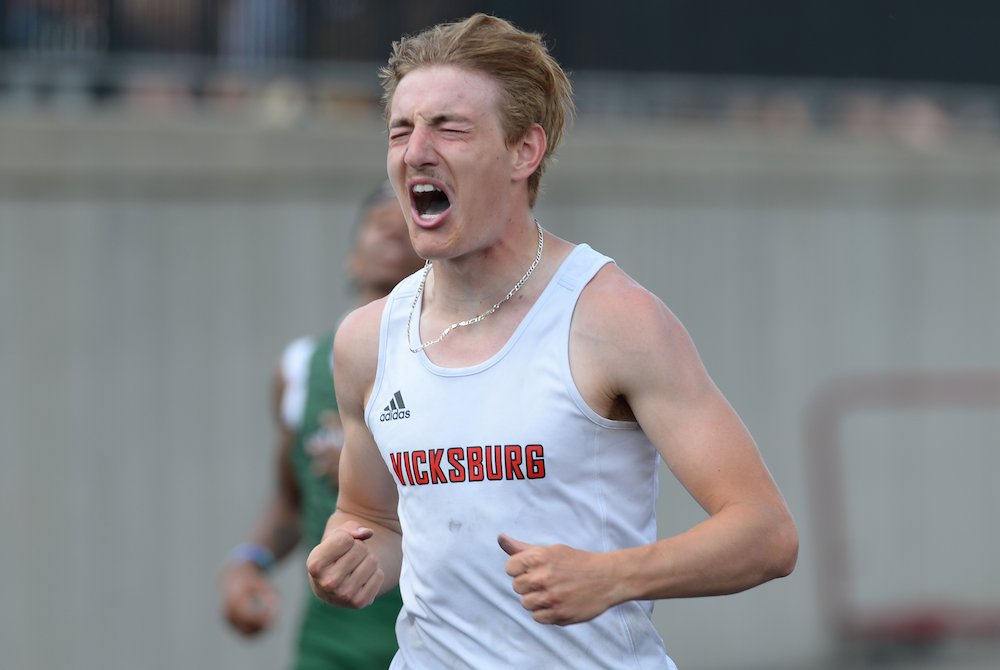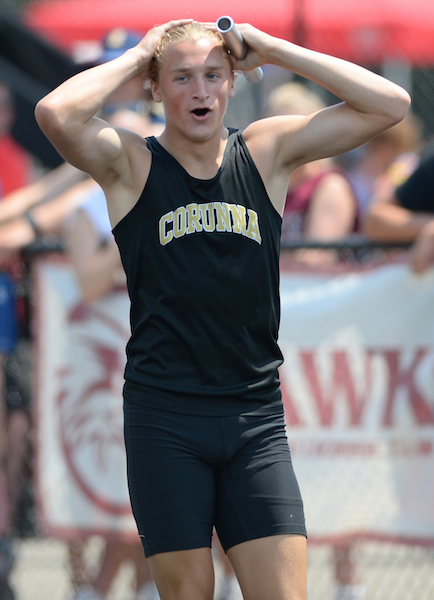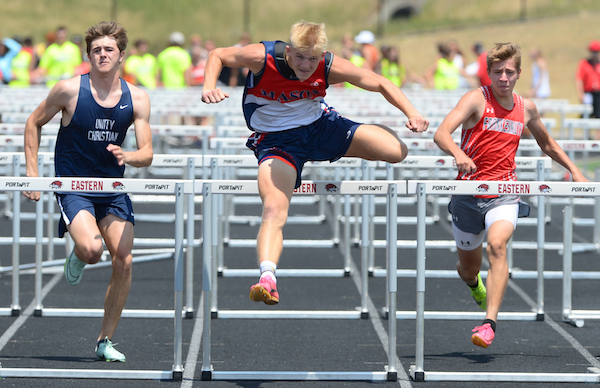
Reigning Champs Lead Again at Zeeland
By
Tom Markowski
Special for Second Half
June 4, 2016
ZEELAND – Orchard Lake St. Mary’s coach Sean Clouse said his team felt the pressure of defending the school’s track and field championship all season.
Noah Jacobs of Corunna said the goal of breaking the nine-minute mark in the 3,200-meter run has been with him since the cross country season ended.
Both St. Mary’s and Jacobs made history Saturday at the Lower Peninsula Division 2 Track & Field Finals held at Zeeland Stadium.
St. Mary’s became the first boys team to win back-to-back titles since Farmington Hills Harrison won three straight (2001-03), as the Eaglets nosed out Mason, 46 points to 44. Zeeland East was third with 33 points, Macomb Lutheran North was fourth with 33 and Grand Rapids Kenowa Hills placed fifth with 29.5.
Kahlee Hamler of St. Mary’s won the 100 dash (10.99) and was on the winning 800 relay team that set a meet record with a time of 1:27.71.
Jacobs became the first LP Division 2 runner to break 9 minutes in the 3,200, as he won with a time of 8:55.57.
Alex Klemm of Macomb Lutheran North set the meet record in the high jump with a jump of 7 feet. Klemm’s previous best was 6-11. Klemm will attend University of Michigan on a track scholarship, and he said he hopes to compete in the long jump and pole vault in addition to the high jump.
“It’s pretty unreal right now,” Klemm said after winning his first individual title.
Both Hamler and Jacobs are juniors.
There were other strong individual performances, including the showing by Mason’s athletes in the field events and another of the state’s top distance runners, Morgan Beadlescomb of Algonac, taking the 1,600 run with a personal-best time.
But it was the Eaglets’ hurdlers and sprinters, led by Hamler, and Corunna’s Jacobs who rose to the top.
“As far as times, it was a bad day,” Hamler said. “But we got things done. It was one of my slower days. My personal best is a 10.75 (in the 100, two weeks ago in the Regional). I wasn’t loose enough. I wasn’t in my right mindset.
“Oh yeah, we had pressure. We worked hard to get here.”
In addition to the sprints, the Eaglets picked up valuable points in the 300 and 110 hurdles. Richard Bowen won the 300 (37.46) and Shermond Dabney placed third. Dabney was fourth in the 110, and both ran on the 800 relay.
Jacobs finished second to Beadlescomb at the LP Division 2 Cross County Final last fall by four seconds. Beadlescomb scratched from the 3,200 on Saturday, saying his right knee wasn’t 100 percent healthy. Jacobs won the event last season with a time of 9:27.49, but lost the competitor who might’ve helped him set a fast pace.
“The clock will tell you what I wanted to do,” Jacobs said. “I wanted to break nine (minutes). It makes it hard (when a runner is so far out in front). For me to reach my goal, that’s what I’ve got to do. They didn’t want to go out that fast.
“It’s so surreal. I’m so blessed. I’m so fortunate to stay healthy. The weather cooled down a bit. It was a perfect day. This is my favorite event. If I had to choose from running in the 3,200 relay with my teammates or this I’d take the relay and run with my teammates in a heartbeat. But, individually, this is it. It’s the kind of event I can thrive in.”
 It was a bittersweet ending for Beadlescomb. He wanted to run both the 1,600 and the 3,200, but it wouldn’t have been the right decision.
It was a bittersweet ending for Beadlescomb. He wanted to run both the 1,600 and the 3,200, but it wouldn’t have been the right decision.
“I won, but I wasn’t too happy,” he said. “I was tired. I don’t know how to explain it. It just happens. When I wanted to make a move it wasn’t there. I had to go back to third. The second time I tried it was there.”
When told he set a personal best in the 1,600 (4:13.18), Beadlescomb was flabbergasted.
“A good race for me is when I start at 2:07 (at the halfway point) and I would hold on from there,” he said. “Today I started with a 2:10. It was crazy.”
Justin Scavarda of Mason won the discus with a throw of 182 feet, 6 inches and the shot put with a put of 57-10½. Mason’s Jarrett VanHavel won the pole vault (15-3), providing the punch for the Bulldogs’ strong team total.
PHOTOS: (Top) The Orchard Lake St. Mary's boys team celebrates its second straight MHSAA championship. (Middle) Algonac's Morgan Beadlescomb leads the pack on the way to winning the 1,600. (Photos by Dave McCauley/RunMichigan.com.)

Vicksburg's Wright, Corunna Right On in Claiming LPD2 Championships
By
Steve Vedder
Special for MHSAA.com
June 3, 2023
ADA – If Michael Wright was a baseball player, he probably would've been called out on strikes a year ago.
Instead, the Vicksburg senior can celebrate after winning the 200 at Saturday's Lower Peninsula Division 2 Track & Field Finals at Forest Hills Eastern.
The road to the championship in the 200, via a time of 21.72, was anything but a straight line for Wright. An aspiring baseball player, he was cut from the Vicksburg squad as a freshman. His football career, by Wright's own admission, was "on and off." And then a year ago in his first track meet, Wright suffered a leg injury that virtually ended his season. He did return to finish fifth in the 200 at Finals while helping the 400 relay team to a 16th place.
So there is nothing to realistically explain how Wright found himself in the position Saturday at sweltering Forest Hills Eastern to win a championship. Except for returning this season to break the school record in the 200 four times in two months. Well, that and willpower and simple desire.
 "I knew I could finish high, maybe in the top five. But this is better," said Wright, who credits drinking large quantities of milk for his resurgence. "I looked to football because I didn't think I could bounce back for track. But I overcame the bumps, the obstacles."
"I knew I could finish high, maybe in the top five. But this is better," said Wright, who credits drinking large quantities of milk for his resurgence. "I looked to football because I didn't think I could bounce back for track. But I overcame the bumps, the obstacles."
While Wright was jump-starting his track career, Corunna won the team title with 41 points. Mason and Forest Hills Eastern tied for second with 35. Whitehall was fourth with 33 points, and Frankenmuth fifth with 29 points.
Corunna coach Jeff Sawyer, who had never won a Finals title in 37 years coaching at Owosso and three more at Corunna, said the championship came after little fanfare during the season. Virtually right up until the time Corunna hauled off its first-place trophy, Sawyer said it was never really on his team's mind. The title came after the team managed only a runner-up finish at the Regional.
"We kind of low-keyed it," he said. "We knew scoring 40 points was possible. We lost to Frankenmuth by one point at the Regional. … We were a little disappointed we didn't win, but we had some good times today. We knew it was possible.
"Every day we just come and do what we do. We talk about getting better every day with PRs (personal records). And we're still getting better because we have some tough guys. Just competitive, tough kids. But we were the underdogs."
Corunna had only two firsts on Saturday, in the 400 relay (42.63) and Wyatt Bower in the long jump (22-8½).
Among the individual highlights was Frankenmuth senior Dalton DeBeau, who successfully defended his Finals title in the discus (171-6). He was fifth in that event as a sophomore and after winning a year ago, was considered a good bet to repeat.
"I kind of expected it," said DeBeau, who will compete at Michigan State next spring. "There wasn't a lot of pressure. I knew what had to be done. I threw 160 feet on my first throw to get in the finals, and that helped right away. I knew I could go all out."
 Berrien Springs' Jake Machiniak won the 100 (10.54) while the team also captured the 800 relay (1:28.18). Machiniak said his season hasn't been without its share of difficulties. There was a time when he couldn't seem to come out of the starting blocks smoothly. But beginning with the conference meet where he ran school record 10:73, Machiniak felt himself back on course.
Berrien Springs' Jake Machiniak won the 100 (10.54) while the team also captured the 800 relay (1:28.18). Machiniak said his season hasn't been without its share of difficulties. There was a time when he couldn't seem to come out of the starting blocks smoothly. But beginning with the conference meet where he ran school record 10:73, Machiniak felt himself back on course.
"There were ups and downs. I struggled in the middle of the season," he said. "But my teammates helped me through some difficulties. I came here to finish the job; I knew I could do something here."
Mason's Tyler Baker won the 100 hurdles (14.63) to complete a long journey that included finishing just ninth in last year's prelims. The success was as simple as putting in loads of offseason work.
"I practiced and did stuff about every day," he said. "I might not be the fastest, but I make up for that in form. It's a fine-tuning thing. Everyone wants to be faster."
Mason also got a championship from A.J. Mantel, who captured the 300 hurdles (38.90).
Among other highlights was Forest Hills Eastern senior Aiden Sullivan successfully defending a 2022 title on his own home turf. He won Saturday's 800 (1:53.92).
Adrian won the 3,200 relay (7:39.77), while Grand Rapids Christian took the 1,600 (3:24.49).
Alma had two individual winners in Michael Howey in the shot (55-08) and Jacob Dunlap in the high jump (6-7).
The other champs were Kyle Eberhard of Linden in the 1,600 (4:14.79), Whitehall's Trannon Ayler in the 400 (48.83), Freeland's T.J. Hansen in the 3,200 (9:11.56) and Sam Vesperman of Grosse Ile in the pole vault (15.01). Chelsea senior Jacob Nelson competed in the adaptive 100 (27.28), 200 (57.71) and shot put (6-6).
PHOTOS (Top) Vicksburg's Michael Wright celebrates after winning the 200 on Saturday. (Middle) Corunna's Tarick Bower enjoys a moment after anchoring the winning 400 relay. (Below) Mason's Tyler Baker, center, works to stay ahead in the 110 hurdles. (Photos by Dave McCauley/RunMichigan.com.)

